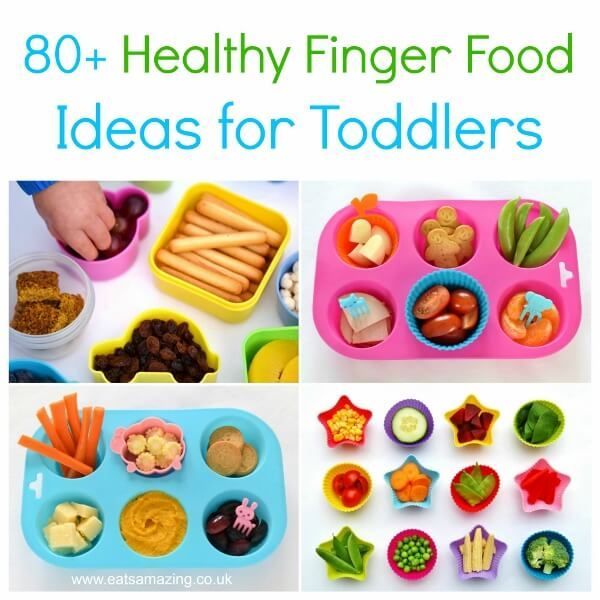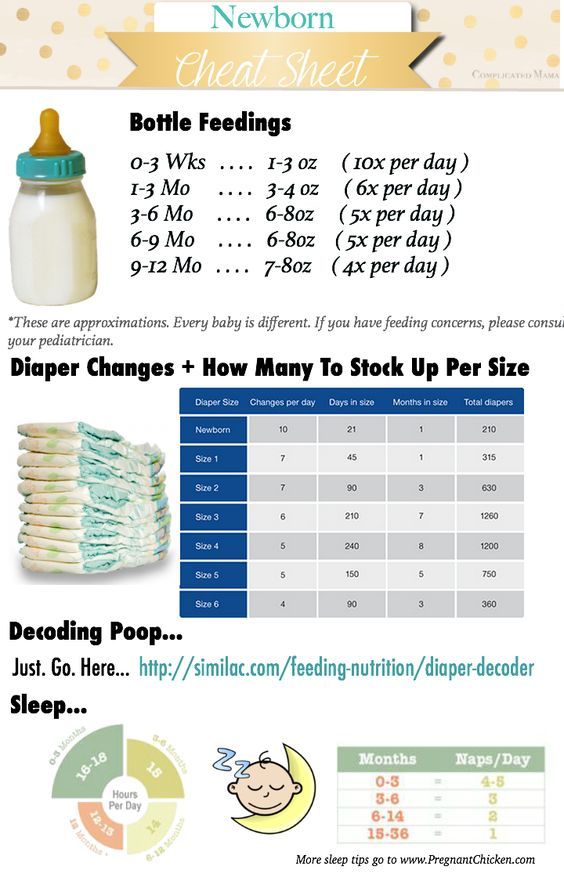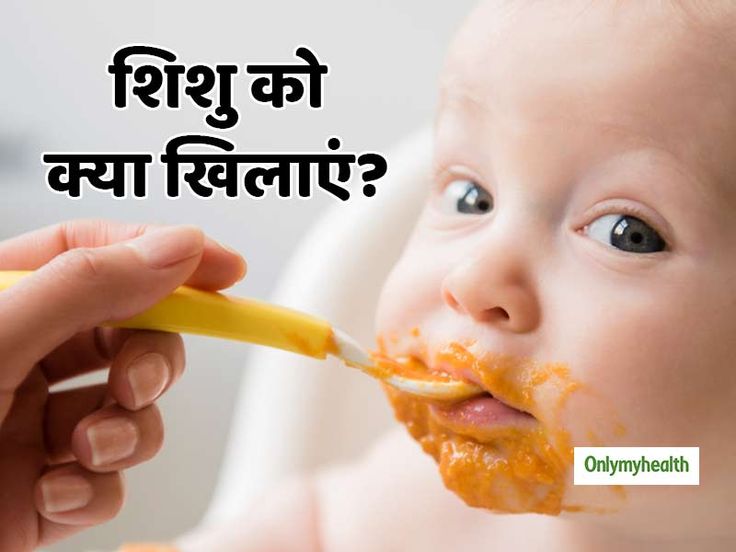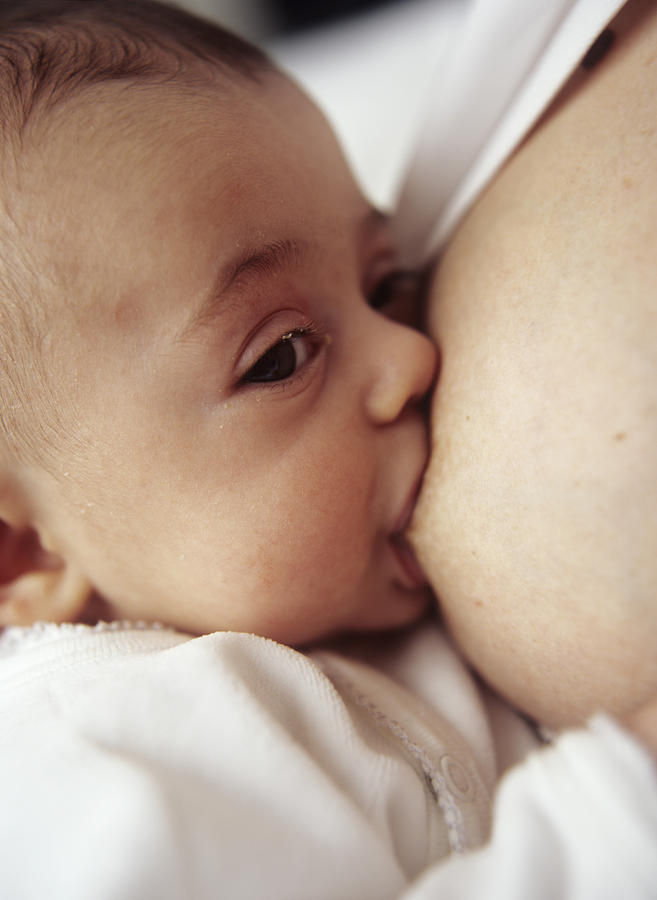What to feed a baby bird fledgling
What to Feed a Fledgling Bird
By Lee Morgan | Updated September 26, 2017During the late spring and summer months it is likely to encounter a baby bird that appears abandoned on the ground. A fledgling bird is actually taught to seek food on its own, while its parents observe from a distance. Do not assume the bird needs your help at first. If the bird remains on its own all day and doesn’t appear to have help from parent birds then you may choose to feed the bird and care for it until you can get it to a wildlife rehabilitator.
Pet Foods
Feed a fledgling bird the same as a dog or cat. Soak dry dog food or cat food in water to make it moist and easy to swallow. The contents of the pet food will be the best temporary diet for the bird, according to the Louisiana SCPA. The bird will open its beak in an attempt to beg for food when it is hungry. Don’t forget to make a homemade nest for the bird to sit in, such as a small bowl lined with paper towels.
Proteins
For many species a baby bird’s diet requires a lot of protein in order to grow at a fast rate, according to The Aviary website. Meat should make up the majority of what you feed to a fledgling bird. Cut up small pieces of raw kidney or liver and give it to the bird using a pair of tweezers to drop into the mouth. Aside from meat, baby birds may also get protein from the whites of a hard-boiled egg cut into small strips. They will also eat the boiled yolk of the egg if it is mashed into a paste. Protein rich dog biscuits soaked in water will also work as a temporary food for fledglings.
No Milk
Do not use milk to soften dry foods for birds, as they are not able to digest it properly, according to the Louisiana SPCA. While it may seen natural to feed babies milk, remember that these creatures are not breast fed mammals and their requirements differ from other animals. Avoid dairy products, because the bird may already be having a hard enough time surviving, without having to cope with digestive problems too.
Feeding
A fledgling bird will need to eat every 15 to 30 minutes from dawn until dusk, according to the Louisiana SPCA. Carefully drop the foods into the mouth of the bird and continue to feed it until it stops opening its mouth and begging for more. Do not touch the bird unless absolutely necessary and keep it in a warm place where it will not be disturbed.
References
- Louisiana SPCA: Helping Injured and Orphaned Birds
- The Aviary: “Abandoned” Birds
Writer Bio
Lee Morgan is a fiction writer and journalist. His writing has appeared for more than 15 years in many news publications including the "Tennesseean," the "Tampa Tribune," "West Hawaii Today," the "Honolulu Star Bulletin" and the "Dickson Herald," where he was sports editor. He holds a Bachelor of Science in mass communications from Middle Tennessee State University.
What to feed a baby bird: A vet's guide to caring for a fledgling
(Image credit: Getty Images)If you’ve found a young fledgling, it's likely that your immediate reaction is to wonder what to feed a baby bird, followed by if and how you can care for the chick vs returning them back to its parents.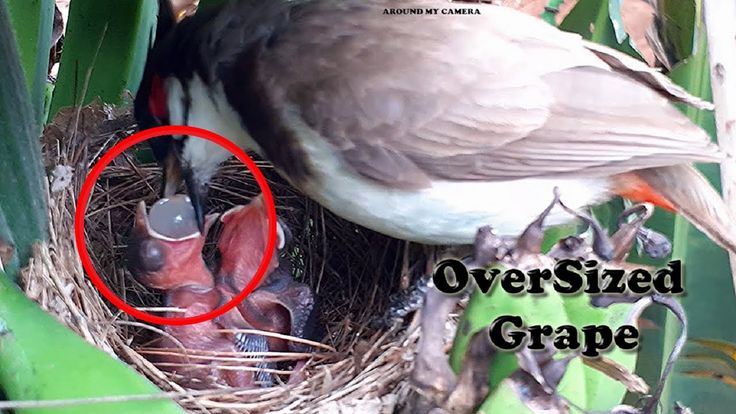
These are surprisingly common queries that many vets hear; baby birds are regular ‘wildlife rescues’ and knowing what to do if you’ve found a nestling, a fledgling, or an injured baby bird is important. Afterall, you can't reach for the nearest premium bird feeder and satisfy their hunger the usual way!
This article will outline what you need to know about rescuing a baby bird, including answering questions around what do baby birds eat, whether you should attempt to care for a bird yourself and how to take care of an abandoned bird if the need arises.
- Amazon: Save on bird food including up to 45% off Kaytee
What to do with a baby bird
If you’ve found a baby bird on the floor, or one has been brought in by your cat, the first thing to do is get it to a safe place. Gently pick it up – you can use a tea towel if you’d rather not touch it – and put it into a box. Any sort of box with a lid that’s large enough will work – you don’t need to make it perfect, just get it contained and in the dark whilst you work out what to do next. Try to have a peek at it as you lift it. Is it injured? Is there any blood?
Try to have a peek at it as you lift it. Is it injured? Is there any blood?
Now, you need to decide if you’ve rescued a nestling or a fledgling. By far the most common rescues are fledglings. These young birds are just learning to fly, so they spend a lot of time on the ground. This means you’re more likely to spot them, and they’re more at risk of being caught by the cat!
Fledglings have most or all of their feathers, but might not look as neat as an adult bird. If the baby bird is a fledgling, you can leave him where you found him if it’s safe, or place the box, open and on its side, under a bush, or hanging from a branch so he can hide until he’s ready to try flying again. His parents will be nearby, waiting to feed him. Keep pets inside if possible to give him a fair chance!
A nestling, on the other hand, will have no feathers. He’ll likely have fallen out of his nest, and you may find more than one baby bird, or even a whole nest on the ground. Have a look for the nest – if you can see it, pop him back in there and leave him – his parents will carry on feeding him.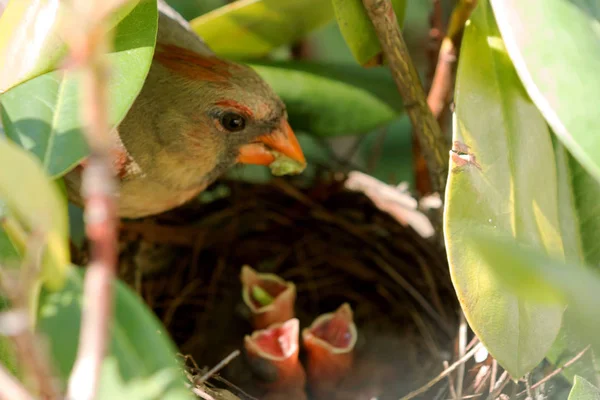 If the nest is on the ground, prop it up high or – even better – wire it into the bush or tree it fell from so that it’s safe from predators. If you can’t see it, or it’s damaged, try using a plant pot with some nest material, and wire it to a bush.
If the nest is on the ground, prop it up high or – even better – wire it into the bush or tree it fell from so that it’s safe from predators. If you can’t see it, or it’s damaged, try using a plant pot with some nest material, and wire it to a bush.
If you can’t return the baby bird to his parents, or you’ve tried but have seen no sign of them after continuous watching of two or more hours, you may have to consider hand-rearing the bird.
(Image credit: Getty Images)Should I look after this baby bird?
Hopefully you’ve tried to return the bird to his parents – hand rearing is hard work, and nowhere near as rewarding as they make it sound in books. Feeding needs to happen frequently – as often as every 20 minutes – during daylight hours, so this is a big responsibility. Most people don’t have the equipment and experience necessary, so taking in a bird should be a last resort.
Hand reared birds struggle to survive in the wild and are unlikely to ever live a normal life unless they’ve been reared by a professional.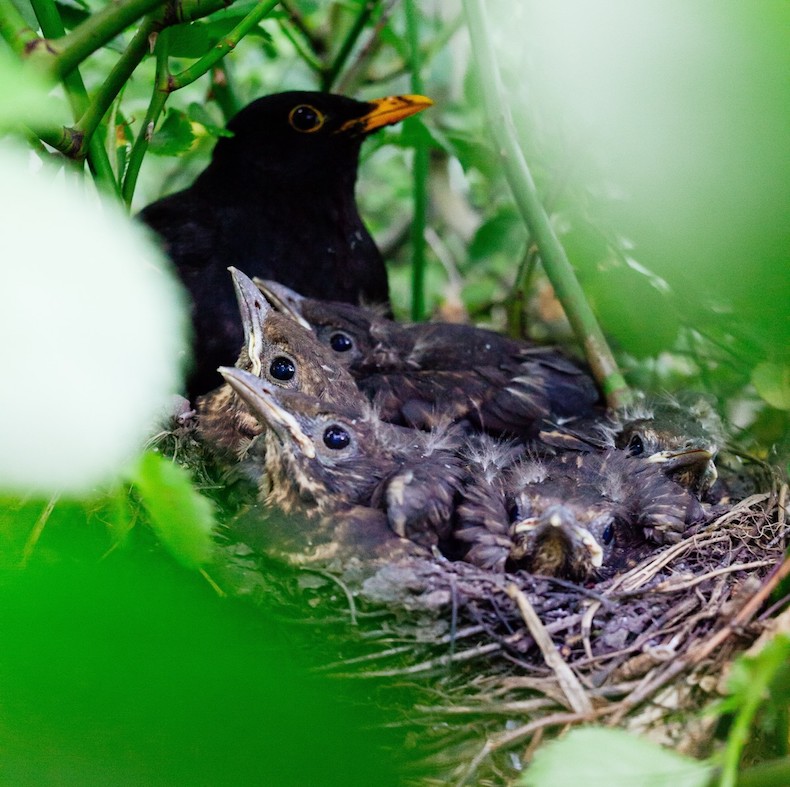 It’s also extremely common for baby birds to die from stress, incorrect diet, or undiagnosed injury or illness – so be prepared. Lastly, you’ll need to check your local law. In some areas, it’s illegal to keep wildlife captive unless you have a license, or it may be illegal to release the bird again once you’ve brought it into the house.
It’s also extremely common for baby birds to die from stress, incorrect diet, or undiagnosed injury or illness – so be prepared. Lastly, you’ll need to check your local law. In some areas, it’s illegal to keep wildlife captive unless you have a license, or it may be illegal to release the bird again once you’ve brought it into the house.
If you’re sure the bird has been abandoned, the best option is to see if there’s a nearby wildlife rescue or shelter that will take the bird, as this will give the bird the best chance of being safely released. If this isn’t possible, see if they can tell you what species of bird it is and give you any advice or equipment.
(Image credit: Getty Images)How do you take care of an abandoned baby bird?
If you can’t find anybody else to take the bird and you really want to give it a shot, it’s time to find out how to take care of an abandoned baby bird. Here’s all you need to know:
Housing an abandoned baby bird
You’ll need to find somewhere suitable for the baby bird to live until it’s old enough to be released. For a fledgling, this is easy – they’re already out of the nest so you just need to provide a safe space in the garden that they can escape when they’re ready.
For a fledgling, this is easy – they’re already out of the nest so you just need to provide a safe space in the garden that they can escape when they’re ready.
For a nestling, you’ll need a box lined with something non-slip easy to clean – birds are messy! Don’t forget that the box should be pet-proof! They’ll also need a ‘nest’, as this supports their weight and allows normal development of their bones. Place the box in a quiet place. It’s best not to use a heat lamp unless it’s very cold, as a nestling will be unable to move away if they’re too hot.
What do baby birds eat? How to feed a baby bird that fell out of its nest
If your bird is a nestling, you’ll need to feed from a syringe or pipette. These birds would be being fed regurgitated food from mum and dad, so they’ll need a soft food. A common option is a mix of cat/dog food, hardboiled eggs, and crushed mealworms, but your wildlife rehabber will be able to give you a more exact recipe designed for the age and species of the bird.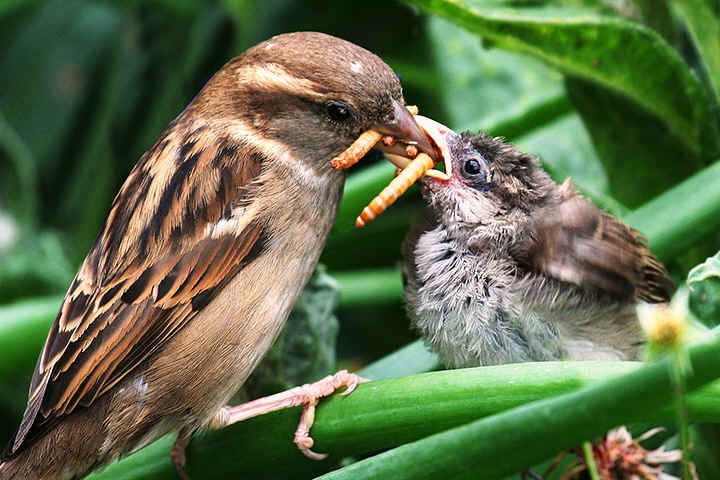 You’ll need to find out how to make the baby bird food, how long it can stay in the fridge for, and how often to feed the baby bird.
You’ll need to find out how to make the baby bird food, how long it can stay in the fridge for, and how often to feed the baby bird.
If you’re wondering what to feed a fledgling baby bird, don’t worry – this is much easier! Fledglings will still be being fed by their parents, but they’re picking up many of the skills they need to feed themselves. First, try offering a bird food mix of seeds and mealworms, and see if the bird helps himself. If he does, great! If not, you’ll need to find out what sort of bird he is, and feed him his preferred food – often softened mealworms – from a pair of tweezers until he’s a little older.
(Image credit: Getty Images)Can you give baby birds water?
It’s very important that birds don’t get dehydrated, but it’s difficult to safely give water to a baby bird. Nestlings should not be given water – they won’t know what to do with it and might drown in it. Both nestlings and fledglings that are not yet feeding themselves will get their water from their diet – so they’ll need access to moist foods. Fledglings that can feed themselves can be given a shallow dish of water until they recover from their shock and fly away.
Fledglings that can feed themselves can be given a shallow dish of water until they recover from their shock and fly away.
Conclusion
Knowing what to do with a baby bird that’s been abandoned is tough. Whilst our instinct is to rescue and look after them, it’s generally not in the bird’s best interests – they’re better off outside and rarely do well when hand reared.
If you do end up feeding a baby bird, take as much advice as possible from an experienced bird rehabilitation centre to maximise the chances of a successful release.
After graduating as a veterinarian from the University of Nottingham, Dr Joanna Woodnutt went on to practice companion animal medicine in the Midlands. She quickly developed a love of consulting and helping clients with medical problems such as dermatology, behaviour and nutrition - anything that involved helping clients understand their pets better. Jo started writing about pet health in 2017, realising that it meant she could help even more pet parents. Since then, she has written for countless online and print publications and is a regular contributor for Edition Dog Magazine. Jo now lives in the Channel Islands with her husband Ian and terrier Pixie, and they are expecting their first child very soon.
Since then, she has written for countless online and print publications and is a regular contributor for Edition Dog Magazine. Jo now lives in the Channel Islands with her husband Ian and terrier Pixie, and they are expecting their first child very soon.
How to save a chick that has fallen out of the nest | Encyclopedia of Animals
With the advent of warm weather, our forests and gardens are filled with bird songs, and people, in turn, try to spend as much time as possible outdoors. During outdoor recreation, helpless chicks are often found. Naturally, there is a desire to save the life of a baby, but not everyone knows how to save a chick that has fallen out of the nest. Let's see how we can help him.
To save or not to save - that is the question
The first thought that arises when looking at a fledgling and flightless chick is “fell out of the nest”, “lost” and even “parents abandoned and forgot”. In fact, the chick is alone, no brothers, sisters, or adult birds are visible nearby, and it also screams loudly. How can you help here? But the fact of the matter is that help in 95% of cases in such situations is not needed.
How can you help here? But the fact of the matter is that help in 95% of cases in such situations is not needed.
The fact is that in many birds (primarily small passerines) chicks leave the nest as half-fledged fledglings. During this period of life, they still do not know how to fly, but they are already actively exploring the surrounding space - they climb branches, clumsily flit. It is these rather active chicks that fall into the field of human vision. It is easy to determine the fledgling in appearance: it is feathered or covered with rudiments of unopened feathers; the chick is quite large (about 50-70% of the size of a sparrow), it is often active, that is, it opens its mouth and asks for food. Parents did not abandon this chick, but simply flew away for food. Of course, while you are standing next to the chick, they will not make themselves felt. And if you stay too long, then there is a chance that the parents will leave him out of concern.
Even if the chick looks too small and helpless, don't rush to classify it as an orphan. Birds such as warblers, warblers, larks, wagtails nest on the ground, their chicks spend their entire childhood on the grass. Your presence in this situation is also undesirable because magpies and crows track human behavior. Smart birds can check after you leave what you saw there, find and kill the chick. Hence the conclusion: do not "save" everything that catches your eye. If the chick is dry, warm, active, well feathered, then he does not need help.
Birds such as warblers, warblers, larks, wagtails nest on the ground, their chicks spend their entire childhood on the grass. Your presence in this situation is also undesirable because magpies and crows track human behavior. Smart birds can check after you leave what you saw there, find and kill the chick. Hence the conclusion: do not "save" everything that catches your eye. If the chick is dry, warm, active, well feathered, then he does not need help.
What if the situation causes concern? Perhaps the chick is too weak or obviously fell out of the nest from a great height and cannot be returned to its parents. In this case, you can try to save him, but keep in mind that the likelihood of success will be directly proportional to your diligence, and you will have to put in a lot of work.
What to do first
- Quickly and carefully inspect the place where you found the chick, remember how it looks. In some cases, this will help determine the type of bird.

- Pick up the chick (don't squeeze too hard!) and bring him home as soon as possible.
- On the way, inspect the chick for damage. If the bird has clearly visible fractures of the paws, wings, concussion (how to define it a little lower), then you can’t do without a veterinarian. It is highly desirable to seek help from a veterinarian who specializes specifically in the treatment of birds (unfortunately, such specialists are extremely rare). If there are no obvious signs of a fracture, and the general condition of the chick is satisfactory, then it is better not to torment him, but simply to provide good conditions - nature will do its job and he will recover.
- Providing a chick with food as soon as possible is even more important than furnishing a home for it.
Now a few words on how to define contusion. Usually, chicks get severe bruises either from hitting the ground or when they collide with cars. At the same time, the bird has no wounds on the outside, but a concussion is observed.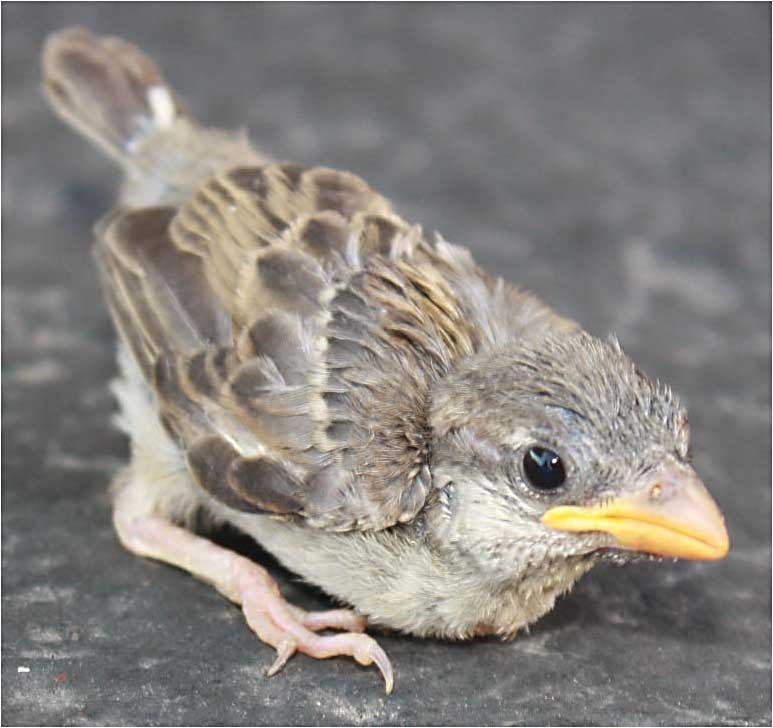 True signs of this condition are bleeding from the nostrils, paralysis of both legs or paralysis of half of the body (paw and wing on one side), closure of one eye, or unequal degree of pupil dilation on the injured and healthy side of the body.
True signs of this condition are bleeding from the nostrils, paralysis of both legs or paralysis of half of the body (paw and wing on one side), closure of one eye, or unequal degree of pupil dilation on the injured and healthy side of the body.
What to feed
You may think that feeding a chick is easy - crumble bread and crumble. But here you will find disappointment number 2. Chicks do not eat bread, crackers, porridge, cereals, seeds. They don't eat at all. Even the chicks of granivorous birds do not take dry food at first. And the reason is that the growing organism needs proteins, therefore, in nature, even granivorous birds feed their offspring with animal food and exceptionally soft food. You will have to do the same. Pigeons are the only exception. They feed the chicks with goiter secretions - bird's milk, and then with semi-digested grains. If you picked up a pigeon chick, then you can feed it with unsalted porridge, gradually reducing the degree of cooking.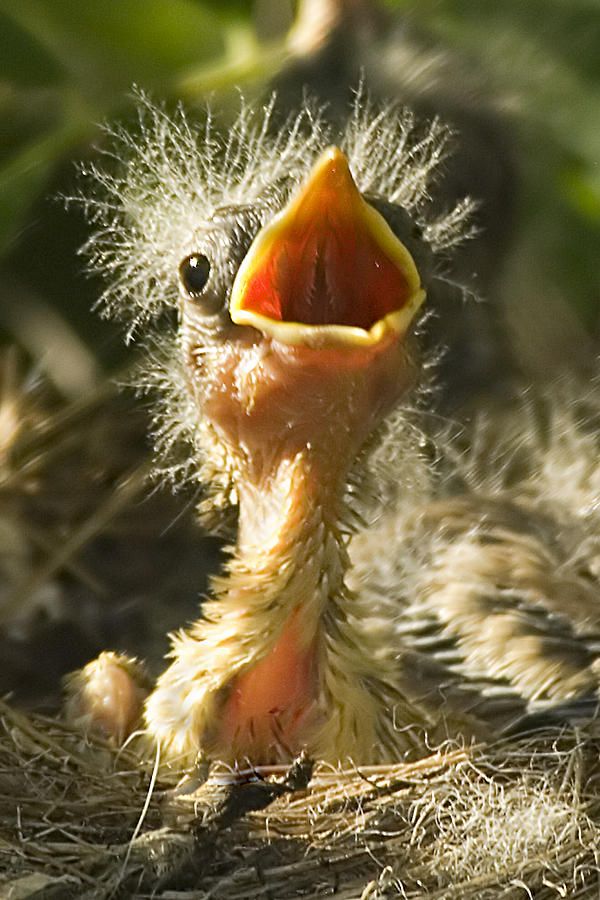 In other cases, the best food for the chick is mealworms, cockroaches, crickets, darkling larvae - zoophobus (all these foods are sold in pet stores), earthworms (you can dig up), caterpillars (you will have to collect), a boiled egg (only as an additional food, and not a substitute for anything and everything). Even if you have provided the chick with the listed food, it is recommended to periodically catch bugs, grasshoppers, butterflies, flies, mosquitoes and give these insects to him, because the more varied the diet, the healthier your ward will grow. Very weak chicks should be given glucose-sweetened water (not sugar syrup!), instead of solid food, for the first few hours.
In other cases, the best food for the chick is mealworms, cockroaches, crickets, darkling larvae - zoophobus (all these foods are sold in pet stores), earthworms (you can dig up), caterpillars (you will have to collect), a boiled egg (only as an additional food, and not a substitute for anything and everything). Even if you have provided the chick with the listed food, it is recommended to periodically catch bugs, grasshoppers, butterflies, flies, mosquitoes and give these insects to him, because the more varied the diet, the healthier your ward will grow. Very weak chicks should be given glucose-sweetened water (not sugar syrup!), instead of solid food, for the first few hours.
What not to feed the chicks
- dead insects - no matter what species they belong to and wherever you find them. In nature, insects almost never live to old age, rather someone will eat them. If you find a dead cockroach behind the stove or a dead locust in the garden, do not rush to rejoice.
 Most likely, this individual died from an insecticide, which means that the poison from the feed can enter the body of the chick and greatly harm its already poor health;
Most likely, this individual died from an insecticide, which means that the poison from the feed can enter the body of the chick and greatly harm its already poor health; - Colorado potato beetles - adults, larvae and eggs are poisonous in this species. They are not eaten by any species of birds, so this easily accessible resource will have to be forgotten;
- ladybugs - they secrete a moderately toxic liquid, in nature a bird that catches such a bug by mistake will spit it out. In captivity, especially in the case of force-feeding the chick, he does not have the opportunity to refuse harmful food, so he can get poisoned;
- hairy caterpillars - firstly, they can be poisonous, and secondly, the villi during feeding can clog the chick's goiter and it will die. Although cuckoos and orioles can eat in the temperate hairy strip, it is still better to play it safe and not use this food;
- brightly colored bugs - in nature, many birds willingly peck at such insects, but this mainly concerns nondescript turtle bugs.
 The back of the bug, decorated with bright spots or stripes, is of a warning nature - "do not eat me, it will be worse for you." For safety net, it is not necessary to catch such specimens for the chick.
The back of the bug, decorated with bright spots or stripes, is of a warning nature - "do not eat me, it will be worse for you." For safety net, it is not necessary to catch such specimens for the chick.
How to feed
The main thing you need to know from the very beginning is that birds have a very high metabolism, and small chicks have a huge metabolic rate. Any food eaten by the chicks is digested very quickly and they need to be fed again and again. In nature, parents jointly feed the brood 100-500 times a day! This means that every 10-15 minutes the chick needs to be fed. And don't expect to overtrain him! A chick deprived of food instantly weakens, a couple of hours of hunger is enough for it to die. You will have to provide the baby with constant supervision, feed him at first every 15 minutes, and when he grows up a little, after 20-30. But you need to take a break at night, but start the first feeding no later than 6 o'clock in the morning! Evening feeding is completed around sunset, that is, around 22.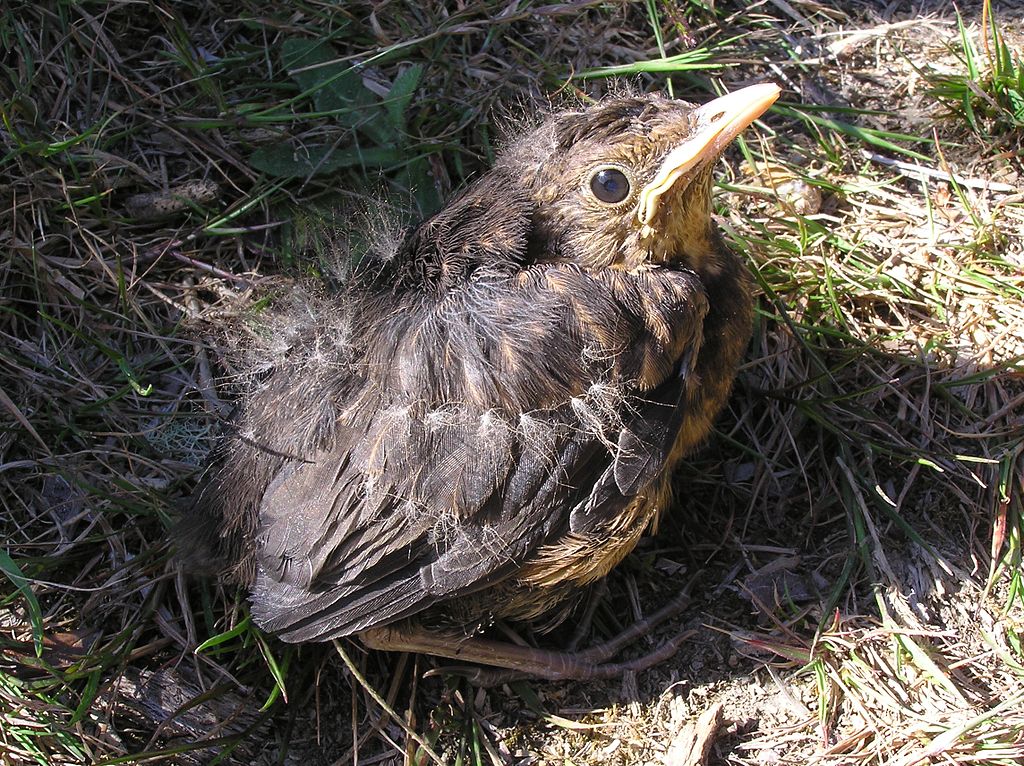 00.
00.
It is more convenient to bring food with tweezers. In general, tactile contact should be kept to a minimum, frequent touching is stressful for the tiny creature, and it worsens the condition of down and feathers. If the chick is very small and naked, then it is not necessary to give it a whole large insects. In this case, it is better to cut them with tweezers and feed them in pieces. It is also recommended to remove hard elytra from large beetles, long legs from grasshoppers and locusts. Often the chicks refuse to take any food. This happens because they do not recognize you as their mother, or they are so weak that they have lost their appetite. In this case, you will have to force-feed the ward. To do this, you need to crush the food and fill it with a syringe without a needle (you can add a couple of drops of water to dilute the mixture). Take the bird in your left hand and gently spread its beak with your fingers, insert a syringe into its mouth with your right hand and squeeze out about 1 cm³ of slurry. Do not overdo it! In tiny chicks, the beak is easily broken, and this is already a fatal injury. For greater convenience, a flexible tube can be put on the end of the syringe.
Do not overdo it! In tiny chicks, the beak is easily broken, and this is already a fatal injury. For greater convenience, a flexible tube can be put on the end of the syringe.
Where to house
If the first difficulties do not dampen your enthusiasm, then you should provide the chick with shelter in your home. First of all, you need to make a nest.
Take a deep bowl or cardboard box with a rim about 10 cm high. Fill this container with sawdust, dry clean sand, hay, straw, scraps of cloth, make a recess in the middle that imitates the nest tray. Do not fill the container with fresh grass, raw material can cause hypothermia of the chick, because there is no one to warm it in an artificial house. By the way, if you are seriously engaged in rescue, you can purchase a small thermal mat at the pet store, it will to some extent replace the mother's warmth for your pupil. Also, cotton wool, yarn, fabrics with a rare weave of threads can be considered dangerous fillers.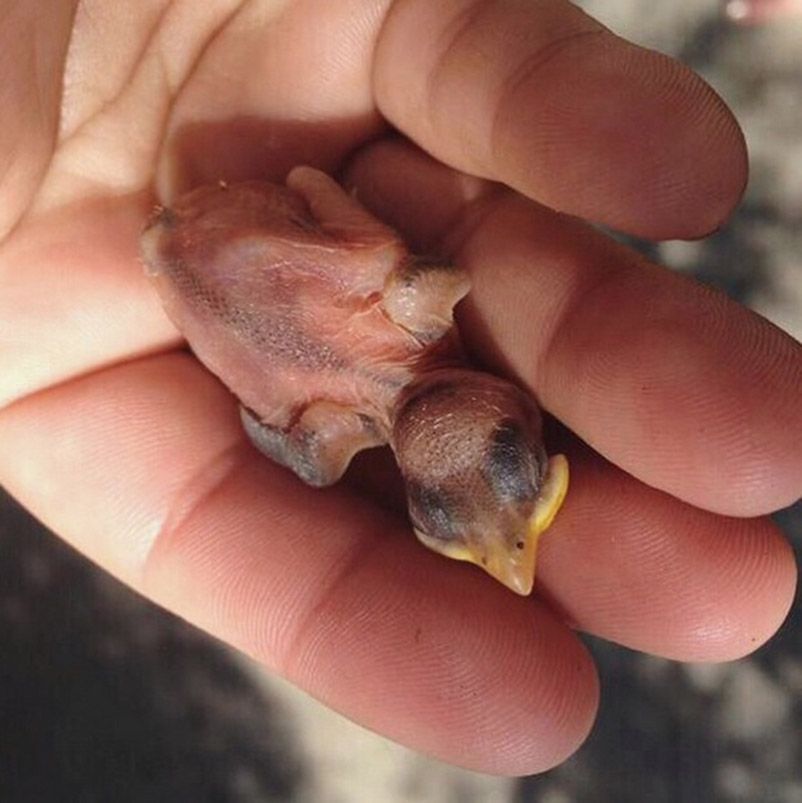 The paws of a chick are easily tangled in such material, and a tightened thread can even amputate the fingers of a feathered baby. Lay a paper napkin in the tray in 2-3 layers. Chicks defecate as often as they eat; in nature, their parents monitor their hygiene and take the litter out of the nest. You just need to change the napkin after each feeding. So, the nest is ready.
The paws of a chick are easily tangled in such material, and a tightened thread can even amputate the fingers of a feathered baby. Lay a paper napkin in the tray in 2-3 layers. Chicks defecate as often as they eat; in nature, their parents monitor their hygiene and take the litter out of the nest. You just need to change the napkin after each feeding. So, the nest is ready.
Now we need to think about security. In the house of the savior, stupid children, blind-sighted grandmothers, dogs, cats can live, and there are also curious neighbors who have dropped in for a minute. All these creatures threaten the life of a little chick: children can grab it and squeeze it in a fist (certain death), dogs and cats can arrange a hunt (you won’t even find feathers), a blind grandmother will sit by chance on a box (well, don’t execute the old woman for this), and noisy neighbors can accidentally knock it over (“Tanya, I’ll come to you for a second for salt, oh, it seems that something has fallen here!”).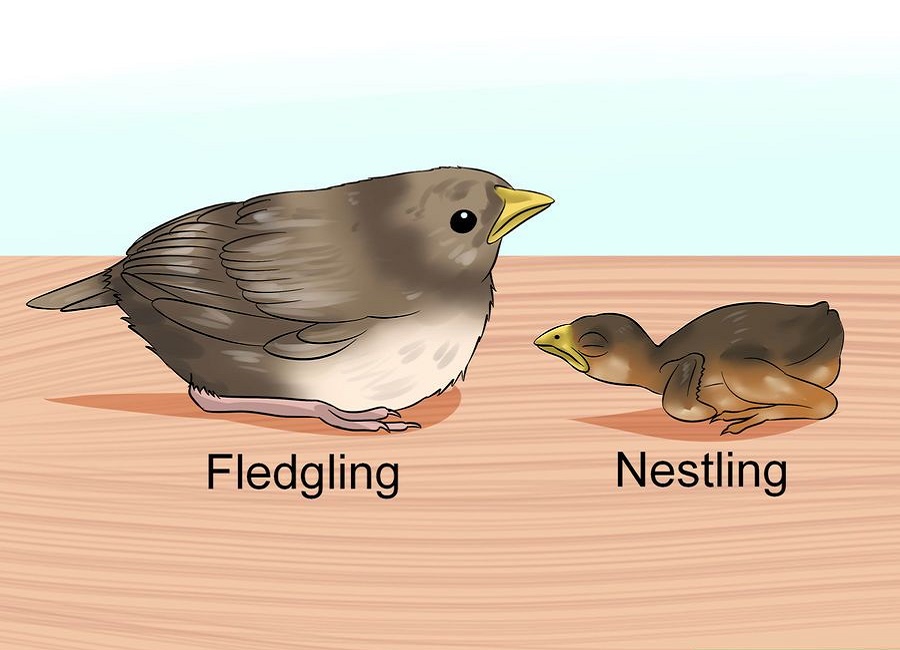 To prevent trouble, it is better to place the nest in a cage or an aquarium covered with gauze. In the cage, do not try to put the chick on the perch, do not place it in closed containers (jars, etc.). Don't nest on high ground. The fact is that a weak chick can get stronger and, unexpectedly for you, will go to explore the surrounding space. He is guaranteed to fall out of his shelter and, unlike the forest and the meadow, it will not be soft grass waiting for him at the bottom, but the floor. You should not put the box with the chick in the sun, so you will not warm it, and the helpless bird is guaranteed to get sunstroke and may die. Drafts are very dangerous.
To prevent trouble, it is better to place the nest in a cage or an aquarium covered with gauze. In the cage, do not try to put the chick on the perch, do not place it in closed containers (jars, etc.). Don't nest on high ground. The fact is that a weak chick can get stronger and, unexpectedly for you, will go to explore the surrounding space. He is guaranteed to fall out of his shelter and, unlike the forest and the meadow, it will not be soft grass waiting for him at the bottom, but the floor. You should not put the box with the chick in the sun, so you will not warm it, and the helpless bird is guaranteed to get sunstroke and may die. Drafts are very dangerous.
Do chicks need water?
In nature, chicks of passerines do not need water, as they get enough moisture with food. After all, adult birds do not bring them water in their beaks. At home, you can do without watering the chick if you follow the diet, that is, you give a variety of, and most importantly, “wet” food - earthworms, fatty juicy caterpillars.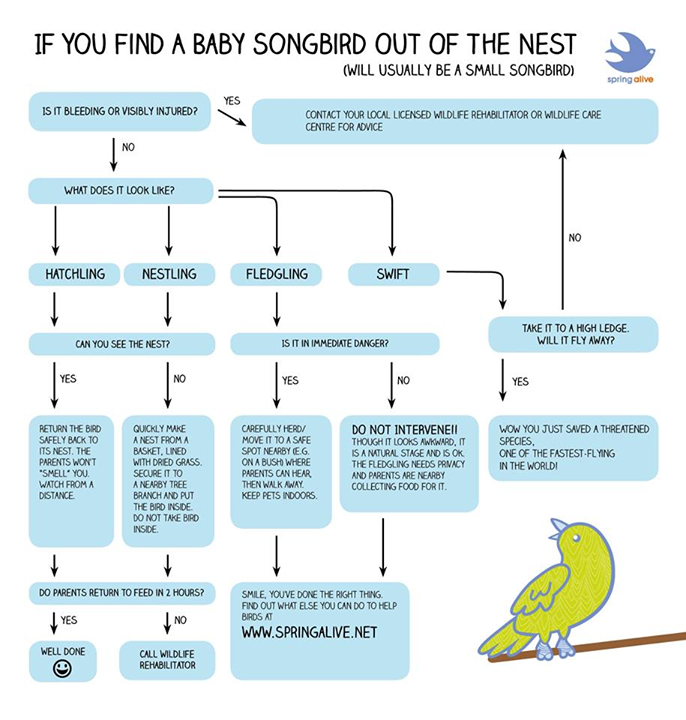 Flies, cockroaches, crickets (they are most often bought in a store) can be conditionally classified as “dry” food. They do not give the chick enough moisture. In this case, he can instill a few drops of liquid from a pipette, but do this not at every feeding, but a little less often. Please note that shell-shocked chicks should not be given water.
Flies, cockroaches, crickets (they are most often bought in a store) can be conditionally classified as “dry” food. They do not give the chick enough moisture. In this case, he can instill a few drops of liquid from a pipette, but do this not at every feeding, but a little less often. Please note that shell-shocked chicks should not be given water.
What to do next?
Fortunately, the chicks grow up quickly and the period of trouble soon passes, in a week or two your ward may get stronger. In order for the feeding process to be completed successfully, do not forget to gradually accustom the chick to adult food. For granivorous birds, this can be porridge cooked without salt, small grains (millet, rice chaff). Chicks of insectivorous species will have to be supplemented with insects. No matter how hard you try, your chick will be weaker than its wild counterparts and completely unsuitable for independent living. There is nothing you can do to help him, so you have to take responsibility for his life. The grown bird will have to be left as a room. If you are not ready to keep a bird (you need to think about this from the very beginning), then it is better not to take the chick home at all. So he will have at least a meager chance to survive. But if you are not afraid of difficulties, then the saved life of the feathered one will be the reward for the labors.
The grown bird will have to be left as a room. If you are not ready to keep a bird (you need to think about this from the very beginning), then it is better not to take the chick home at all. So he will have at least a meager chance to survive. But if you are not afraid of difficulties, then the saved life of the feathered one will be the reward for the labors.
The recommendations in this article are mainly focused on the rearing of passerines and pigeons, as these are the most commonly found. Chicks of large birds (eagles, cranes, owls, storks, etc.) are best transferred to the zoo, where they are guaranteed professional veterinary care.
How do you like the article?
How to feed the found chick, how many times a day
If you find a chick, the first thing you need to do is determine its species. Feeding granivorous, insectivorous and predatory chicks have their own differences. But in the early stages of feeding, you can use the same feeding methods, and then, after finding out what kind of bird you found, transfer the chick to the appropriate feeding.
Here is one of the most common feeding options for granivorous and insectivorous chicks. This nutrient mixture is well used for feeding for chicks and fledglings from the passerine family. To prepare our mixture, we need the following products: Boiled egg, low-fat cottage cheese, raw carrots, meat (beef, chicken, turkey), greens (lettuce, dandelion leaves, wood lice), hamarus and daphnia, Calcium gluconate (shell from boiled eggs) glycerophosphate , children's dry dairy-free porridge or boiled millet (without salt and fat on the water).
Action one. Boil the egg, free from the shell. We free the shell from the shell film. Grind the egg as much as possible, you can use a grater with small holes.
Second step. Boiled meat, it is better to take the pulp from the breast of a turkey or chicken and also chop or divide into fibers. The mixture will require meat 40 (for granivorous) and 60 grams (for insectivorous).
Third step. Take washed carrots of a small size, grate them on a fine grater, then squeeze the juice and we will use the remaining pulp.
Fourth step. We take not sour and not fatty cottage cheese. Cottage cheese should have 0% fat content, anything above is considered fat for poultry. We need 90-110 grams of cottage cheese. Sour cottage cheese must be boiled twice changing the water and then it will be suitable.
Step five. You can use greens to add the mixture, but you can do without it for the chicks. And so you can take the greens listed above, chop and add 1.5 teaspoons to the mixture.
Action six. To the above ingredients, add 1.5 -2 tsp. dairy-free porridge or boiled millet (well boiled, without salt and fat in the water).
Step seven. To the mixture we add the shell from the boiled egg, which must first be ground in a coffee grinder, plus one fourth of the crushed tablet of glycerophosphate. If it is not possible to find glycerophosphate, then you can purchase bone meal and add one fourth tsp. in powder form. At the very least, the shells are enough for now.
Step eight. We take chopped hamarus and daphnia and add about 1 tsp to the resulting mixture. Then we mix everything, it turns out a very thick, crumbly porridge, it should not stick to the fingers. If the mixture is sticky, you can add dairy-free porridge or powdered cereals.
Then we mix everything, it turns out a very thick, crumbly porridge, it should not stick to the fingers. If the mixture is sticky, you can add dairy-free porridge or powdered cereals.
From the resulting mixture we roll small balls no larger than a small pea, focus on the size of the chick's beak. You can feed 2-5 balls at a time and after each feeding drink plain water from an insulin syringe with a removable needle (without a needle) 4-6 drops. A week-old chick should be fed every 1-1.5 hours, older than two weeks of age every 2-4 hours, at three and four weeks of age you can feed 3-4 times a day. Do not forget that the chick is growing and, accordingly, one-time portions of food are growing. A very important point, do not forget to warm the chicks, because at their age they themselves cannot maintain normal body temperature. Warming up promotes better assimilation of feed. Don't forget to control your chick's weight. If possible, show the chick to a specialist. To control the work of the intestines, you can take the litter from the chick for a coprogram, this is an analysis of the digestibility of the feed.


